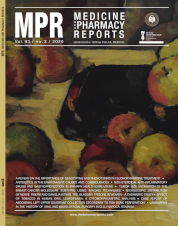A review on the importance of genotyping and phenotyping in fluoropyrimidine treatment
DOI:
https://doi.org/10.15386/mpr-1564Keywords:
chemotherapy, fluoropyrimidine treatment, toxicityAbstract
Fluoropyrimidines, after more than 50 years from their discovery, are still the treatment of many types of cancer, and it is estimated that two million patients receive fluoropyrimidine therapy annually. The toxicity associated with fluoropyrimidines affects 30-40% of patients and some adverse effects can be lethal.
Dihydroypyrimidine dehydrogenase is the main enzyme in the catabolism of 5-FU and DPD activity deficiency can cause important toxicity. This is an important reason to determine DPD activity in order to improve patient safety and to limit potential life-threating toxicity.
At presentmultiple phenotypic and genotypic methods are available for the determination of DPD activity, some of these methods have proven their usefulness in practice, and yet they are not routinely recommended in clinical practice.
This review is another statement of the importance of the determination of DPD status, the phenotypic and genotypic methods that are available and can be used.
Downloads
Published
How to Cite
Issue
Section
License
The authors are required to transfer the copyright of the published paper to the journal. This is done by agreeing to sign the Copyright Assignment Form. Whenever the case, authors are also required to send permissions to reproduce material (such as illustrations) from the copyright holder.

The papers published in the journal are licensed under a Creative Commons Attribution-NonCommercial-NoDerivatives 4.0 International License.

